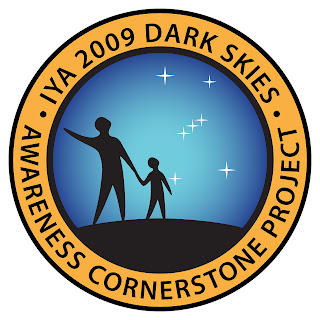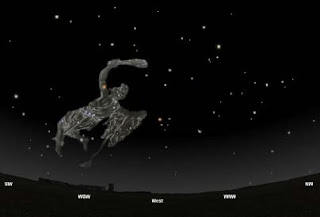 Turning out the lights for "Earth Hour" is going to be a great way to demonstrate caring about climate changes by turning off the lights - but what about the impact that light pollution has on our skies? 2008 marked a monumental shift in human history when the number of people living in cities exceeded half the people on Earth. Because of the ambient light of urban landscapes, many city dwellers have never seen a sky full of stars. Are you interested in helping science study the impact of lighting in your area? Then step inside and learn more about GLOBE…
Turning out the lights for "Earth Hour" is going to be a great way to demonstrate caring about climate changes by turning off the lights - but what about the impact that light pollution has on our skies? 2008 marked a monumental shift in human history when the number of people living in cities exceeded half the people on Earth. Because of the ambient light of urban landscapes, many city dwellers have never seen a sky full of stars. Are you interested in helping science study the impact of lighting in your area? Then step inside and learn more about GLOBE…GLOBE at Night is a wonderful way for everyone around the world to
 participate as a citizen-sciencist to raise public awareness of the impact of artificial lighting on local environments. This event encourages everyone - students, educators, dark sky advocates and the general public - to measure the darkness of their local skies and contribute their observations online to a world map. GLOBE at Night is a centerpiece of the Dark Skies Awareness Global Cornerstone Project for the International Year of Astronomy (IYA) in 2009, and we need people - just like you - to get involved! Data collection and online reporting is simple and user-friendly.
participate as a citizen-sciencist to raise public awareness of the impact of artificial lighting on local environments. This event encourages everyone - students, educators, dark sky advocates and the general public - to measure the darkness of their local skies and contribute their observations online to a world map. GLOBE at Night is a centerpiece of the Dark Skies Awareness Global Cornerstone Project for the International Year of Astronomy (IYA) in 2009, and we need people - just like you - to get involved! Data collection and online reporting is simple and user-friendly. Led by the educational outreach staff at the National Optical Astronomy Observatory and the University Corporation for Atmospheric Research GLOBE Program, the GLOBE at Night campaign will take place for a 4th year from March 16-28, 2009. “The geographic reach of the GLOBE at Night program exceeded our wildest expectations,” said Connie Walker, an astronomer and science education specialist at the National Optical Astronomy Observatory (NOAO), one of the event’s major co-sponsors. “We fell a few hundred short of our target of 5,000 total observations, but the engagement and excitement of large family groups, and dozens of school children participating in the activity together, more than make up for a few less data points.”
Led by the educational outreach staff at the National Optical Astronomy Observatory and the University Corporation for Atmospheric Research GLOBE Program, the GLOBE at Night campaign will take place for a 4th year from March 16-28, 2009. “The geographic reach of the GLOBE at Night program exceeded our wildest expectations,” said Connie Walker, an astronomer and science education specialist at the National Optical Astronomy Observatory (NOAO), one of the event’s major co-sponsors. “We fell a few hundred short of our target of 5,000 total observations, but the engagement and excitement of large family groups, and dozens of school children participating in the activity together, more than make up for a few less data points.” Over the past 3 years, tens of thousands of citizen-scientists around the world have contributed measurements of their local sky brightness to a growing global database in two ways: simple unaided-eye observations toward the constellation Orion and quantative digital measurements through a handheld, well-calibrated sky-brightness meter. For the first method, citizen-scientists take data on light pollution levels by comparing what they see toward Orion, with star maps showing different stellar brightness limits. The basic idea is to look for the faintest stars and match them to one of seven star maps of progressively fainter limiting magnitudes. For the second method, digital sky-brightness meters are used for more precise measurements. The low-cost digital Sky Quality Meters (SQMs), manufactured by Unihedron, can make a highly repeatable, direct measurement of integrated sky brightness. The newly available second-generation of SQM-Ls being used this year by several GLOBE at Night sites has a cone-shaped “field of view” that is three times more narrow than the older model. This specifically aids its use in city environments, where surrounding lights or buildings may affect the readings.
Over the past 3 years, tens of thousands of citizen-scientists around the world have contributed measurements of their local sky brightness to a growing global database in two ways: simple unaided-eye observations toward the constellation Orion and quantative digital measurements through a handheld, well-calibrated sky-brightness meter. For the first method, citizen-scientists take data on light pollution levels by comparing what they see toward Orion, with star maps showing different stellar brightness limits. The basic idea is to look for the faintest stars and match them to one of seven star maps of progressively fainter limiting magnitudes. For the second method, digital sky-brightness meters are used for more precise measurements. The low-cost digital Sky Quality Meters (SQMs), manufactured by Unihedron, can make a highly repeatable, direct measurement of integrated sky brightness. The newly available second-generation of SQM-Ls being used this year by several GLOBE at Night sites has a cone-shaped “field of view” that is three times more narrow than the older model. This specifically aids its use in city environments, where surrounding lights or buildings may affect the readings. To learn the five easy steps to participate in either type of GLOBE at Night program and to obtain important information on light pollution, stellar magnitudes, the mythology of Orion, how to find Orion, how to obtain your latitude and longitude, and how to use an SQM, see the GLOBE at Night website. No prior experience is necessary and all the information you need to participate is right there - along with downloads for activity kits for families, teachers and invididuals in six different languages. All observations will be available online via Google Earth and as downloadable datasets, too.
To learn the five easy steps to participate in either type of GLOBE at Night program and to obtain important information on light pollution, stellar magnitudes, the mythology of Orion, how to find Orion, how to obtain your latitude and longitude, and how to use an SQM, see the GLOBE at Night website. No prior experience is necessary and all the information you need to participate is right there - along with downloads for activity kits for families, teachers and invididuals in six different languages. All observations will be available online via Google Earth and as downloadable datasets, too.
Thanks to an international network of partners, GLOBE reaches people around the world, and during their first two years managed 20,000 observations from a total of 100 countries. This year, they're hoping for an even greater success rate and within weeks of submitting your data, a world map showing the results of your studies will be made available. Using this information, you can then compare the data to previous studies, as well as satellite data and population density data. Collecting information from mulitple locations inside a single city or region is highly encourged, and would make a great class project or astronomy club activity!
By activity participating in projects like GLOBE, you can make difference. More measurements made each year and over the next few years will allow for in more depth analysis. More measurements within a city will provide maps of higher resolution and comparisons between years would allow people to monitor changes. Just like our other Earthly environments, monitoring our lighting environment will allow us as citizen-scientists to identify and preserve dark sky locations in cities or catch an area developing too quickly and influence people to make smart choices in lighting by providing them with informed neighbors. As just everyday, ordinary people, we can impact what happens by educating ourselves and others. If more and more people took a few minutes during the March 2009 campaign to measure sky brightness either toward Orion with the unaided-eye or toward zenith with a Sky Quality Meter (or both!), their measurements - and yours - will make a world of difference!
Cited from : Universe Today - Tammy Plotner





No comments:
Post a Comment